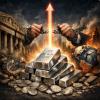
Breaking News
 Brighteon Broadcast News, Jan 7, 2026 - Doctors Replaced by AI...
Brighteon Broadcast News, Jan 7, 2026 - Doctors Replaced by AI...
 US Blockade Of Venezuela Triggers New Spike In Silver Price!
US Blockade Of Venezuela Triggers New Spike In Silver Price!
 Elon Musk Expects True AGI in 2026-2027 and Superintelligence About 2030...
Elon Musk Expects True AGI in 2026-2027 and Superintelligence About 2030...
 They Can't Stop The Unstoppable Rise Of Silver...
They Can't Stop The Unstoppable Rise Of Silver...
Top Tech News
 The First Production All-Solid-State Battery Is Here, And It Promises 5-Minute Charging
The First Production All-Solid-State Battery Is Here, And It Promises 5-Minute Charging
 See inside the tech-topia cities billionaires are betting big on developing...
See inside the tech-topia cities billionaires are betting big on developing...
 Storage doesn't get much cheaper than this
Storage doesn't get much cheaper than this
 Laser weapons go mobile on US Army small vehicles
Laser weapons go mobile on US Army small vehicles
 EngineAI T800: Born to Disrupt! #EngineAI #robotics #newtechnology #newproduct
EngineAI T800: Born to Disrupt! #EngineAI #robotics #newtechnology #newproduct
 This Silicon Anode Breakthrough Could Mark A Turning Point For EV Batteries [Update]
This Silicon Anode Breakthrough Could Mark A Turning Point For EV Batteries [Update]
 Travel gadget promises to dry and iron your clothes – totally hands-free
Travel gadget promises to dry and iron your clothes – totally hands-free
 Perfect Aircrete, Kitchen Ingredients.
Perfect Aircrete, Kitchen Ingredients.
 Futuristic pixel-raising display lets you feel what's onscreen
Futuristic pixel-raising display lets you feel what's onscreen
 Cutting-Edge Facility Generates Pure Water and Hydrogen Fuel from Seawater for Mere Pennies
Cutting-Edge Facility Generates Pure Water and Hydrogen Fuel from Seawater for Mere Pennies
Nuclear fusion breakthrough breathes life into the overlooked Z-pinch approach

Tokamak reactors and fusion stellarators are a couple of the experimental devices used in pursuit of these lofty goals, but scientists at the University of Washington (UW) are taking a far less-frequented route known as a Z-pinch, with the early signs pointing to a cheaper and more efficient path forward.
In order to mimic the conditions inside the Sun, where hydrogen atoms smash together to form helium atoms and release gargantuan amounts of energy with no harmful by-products, we need a whole lot of heat and a whole lot of pressure.
Forming a stream of plasma and holding it in place long enough for these nuclear reactions to occur, either in a twisted loop or a neat donut shape, are the techniques employed by devices like Germany's wonky Wendelstein 7-X fusion reactor and China's Experimental Advanced Superconducting Tokamak. But this approach has its drawbacks, relating to the magnetic coils needed to suspend the ring of plasma, as study author Uri Shumlak explains to New Atlas.



